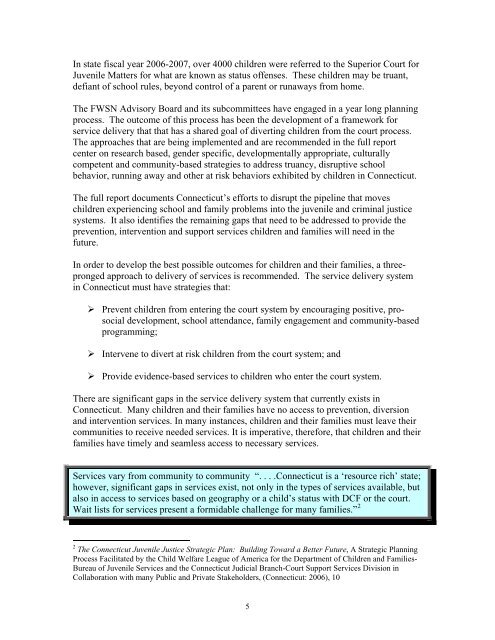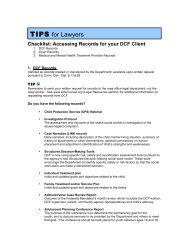FWSN-advisorybd-repo.. - The Connecticut Juvenile Justice Alliance
FWSN-advisorybd-repo.. - The Connecticut Juvenile Justice Alliance
FWSN-advisorybd-repo.. - The Connecticut Juvenile Justice Alliance
Create successful ePaper yourself
Turn your PDF publications into a flip-book with our unique Google optimized e-Paper software.
In state fiscal year 2006-2007, over 4000 children were referred to the Superior Court for<br />
<strong>Juvenile</strong> Matters for what are known as status offenses. <strong>The</strong>se children may be truant,<br />
defiant of school rules, beyond control of a parent or runaways from home.<br />
<strong>The</strong> <strong>FWSN</strong> Advisory Board and its subcommittees have engaged in a year long planning<br />
process. <strong>The</strong> outcome of this process has been the development of a framework for<br />
service delivery that that has a shared goal of diverting children from the court process.<br />
<strong>The</strong> approaches that are being implemented and are recommended in the full <strong>repo</strong>rt<br />
center on research based, gender specific, developmentally appropriate, culturally<br />
competent and community-based strategies to address truancy, disruptive school<br />
behavior, running away and other at risk behaviors exhibited by children in <strong>Connecticut</strong>.<br />
<strong>The</strong> full <strong>repo</strong>rt documents <strong>Connecticut</strong>’s efforts to disrupt the pipeline that moves<br />
children experiencing school and family problems into the juvenile and criminal justice<br />
systems. It also identifies the remaining gaps that need to be addressed to provide the<br />
prevention, intervention and support services children and families will need in the<br />
future.<br />
In order to develop the best possible outcomes for children and their families, a threepronged<br />
approach to delivery of services is recommended. <strong>The</strong> service delivery system<br />
in <strong>Connecticut</strong> must have strategies that:<br />
‣ Prevent children from entering the court system by encouraging positive, prosocial<br />
development, school attendance, family engagement and community-based<br />
programming;<br />
‣ Intervene to divert at risk children from the court system; and<br />
‣ Provide evidence-based services to children who enter the court system.<br />
<strong>The</strong>re are significant gaps in the service delivery system that currently exists in<br />
<strong>Connecticut</strong>. Many children and their families have no access to prevention, diversion<br />
and intervention services. In many instances, children and their families must leave their<br />
communities to receive needed services. It is imperative, therefore, that children and their<br />
families have timely and seamless access to necessary services.<br />
Services vary from community to community “. . . .<strong>Connecticut</strong> is a ‘resource rich’ state;<br />
however, significant gaps in services exist, not only in the types of services available, but<br />
also in access to services based on geography or a child’s status with DCF or the court.<br />
Wait lists for services present a formidable challenge for many families.” 2<br />
2 <strong>The</strong> <strong>Connecticut</strong> <strong>Juvenile</strong> <strong>Justice</strong> Strategic Plan: Building Toward a Better Future, A Strategic Planning<br />
Process Facilitated by the Child Welfare League of America for the Department of Children and Families-<br />
Bureau of <strong>Juvenile</strong> Services and the <strong>Connecticut</strong> Judicial Branch-Court Support Services Division in<br />
Collaboration with many Public and Private Stakeholders, (<strong>Connecticut</strong>: 2006), 10<br />
5
















